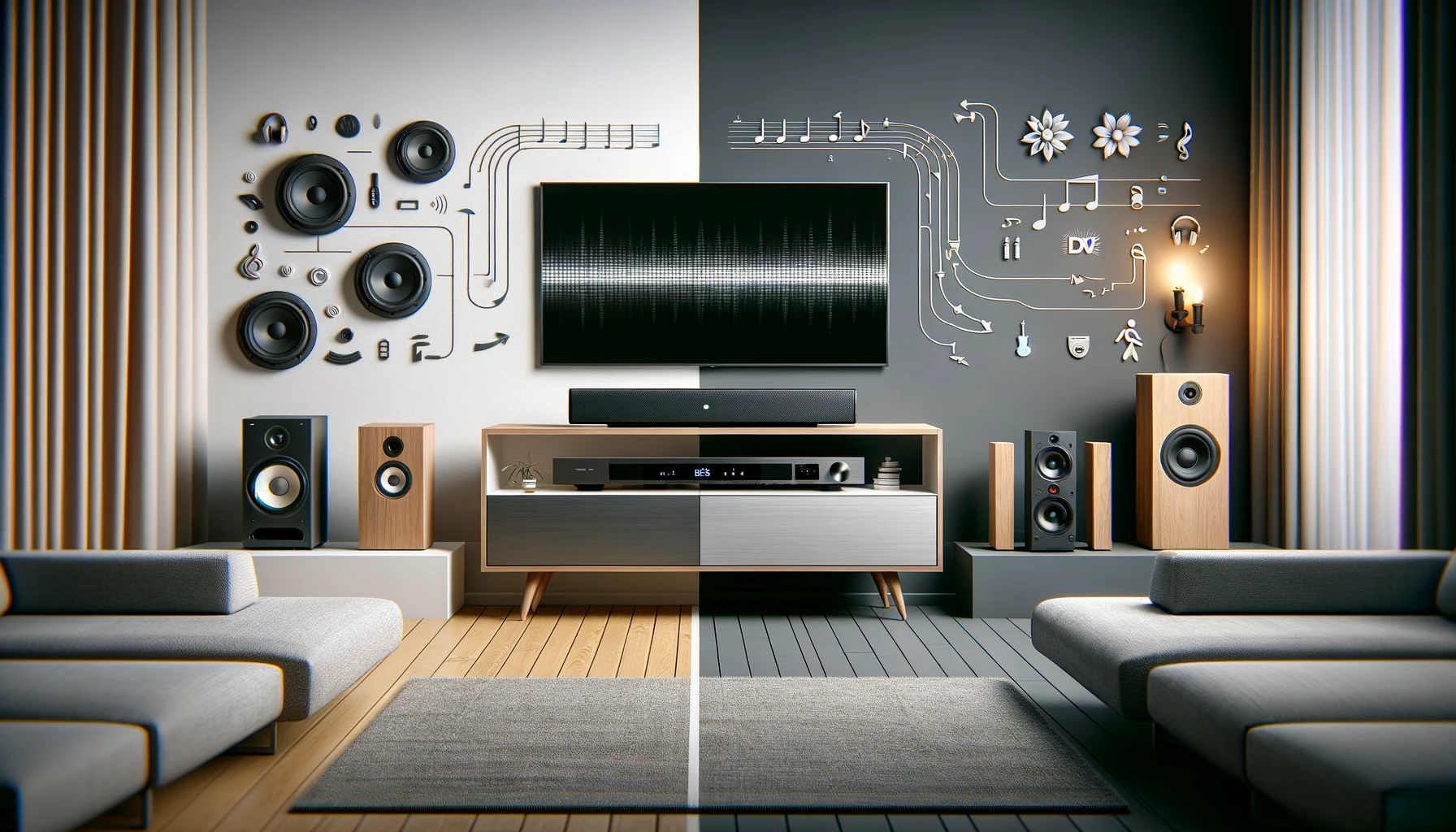Getting better audio from your TV doesn’t require a complicated install. Thesis: Soundbars provide beefed up sound in a simple package, but do you need to add an AV receiver to power surround speakers?
Let’s explore what soundbars offer, where receivers come in, and find out what system best suits your room and audio needs.
Do Soundbars Require an External Receiver?
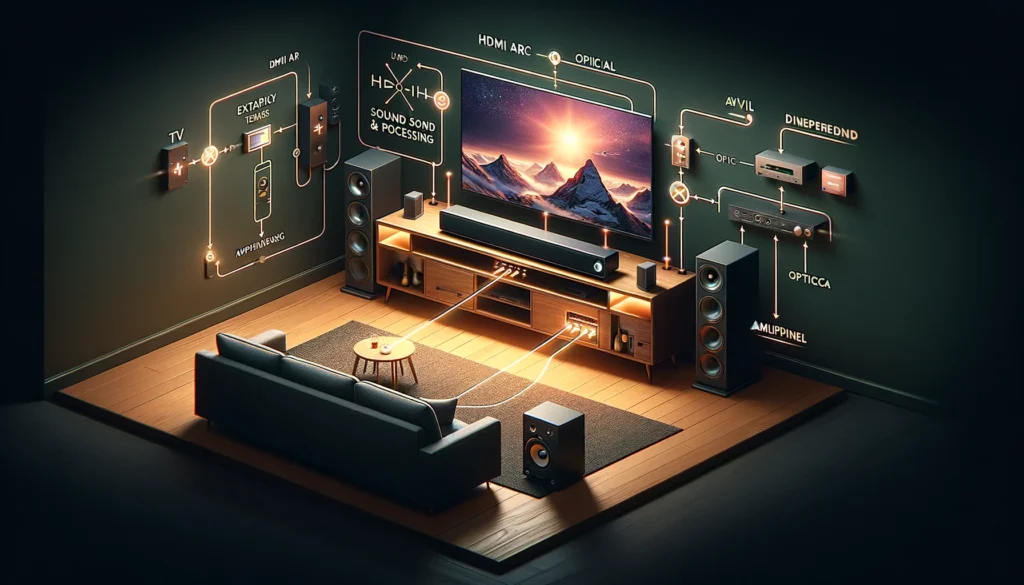
No, most basic soundbar setups do not require an additional AV receiver. The amplification and processing is built into the soundbar, which often connects directly to the TV via HDMI ARC or optical cable.
Wireless soundbars with satellite speakers also do not need a receiver, as the soundbar powers those additional channels.
Surround sound configurations with multiple speakers placed around the room do need an AV receiver for power, discrete channel processing, and custom tuning capabilities.
Now let’s explore specifics around soundbar connectivity, audio quality comparisons, and setup considerations.
What is a Soundbar?
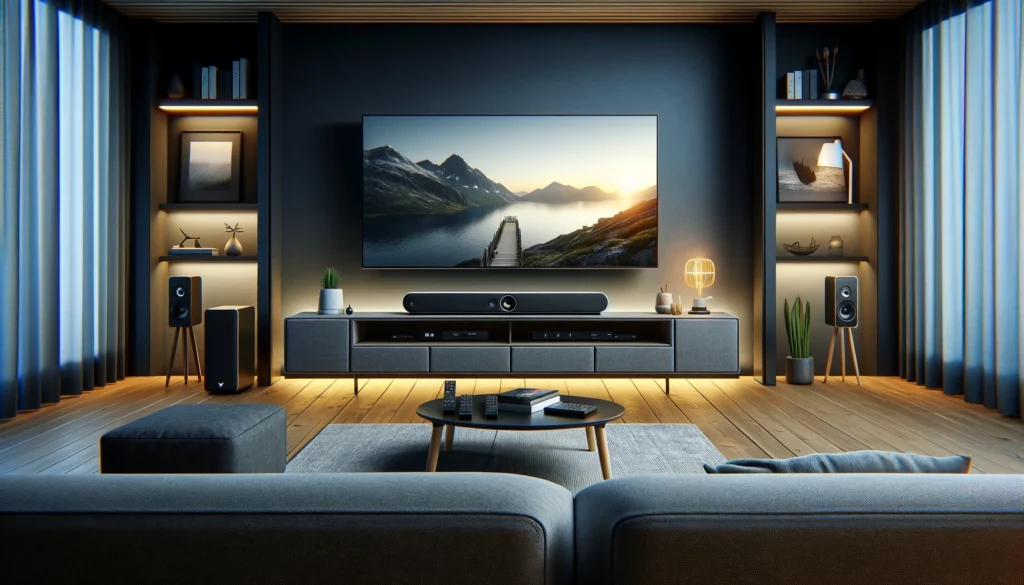
A soundbar is a long, slim speaker that is designed to improve the audio quality from your TV without requiring multiple speakers or a full home theater setup.
Soundbars come in different configurations, ranging from basic 2.1 channel models with two stereo speakers and a subwoofer for bass, up to more advanced 5.1 or 7.1.
Surround sound models with additional satellite speakers or up-firing drivers to create an immersive audio experience.
The main appeal of a soundbar over a home theater speaker system is simplicity and convenience.
Soundbars are compact, with all the necessary audio components like amplifiers and processors built right in, so there is no need for an external audio-video receiver.
They connect directly to the TV, often via one single HDMI cable, for an easy plug-and-play setup. Soundbars provide an audio boost for TV and movies, without requiring multiple speakers wires running around the room or complicated installations.
Do You Need a Receiver for a Soundbar?
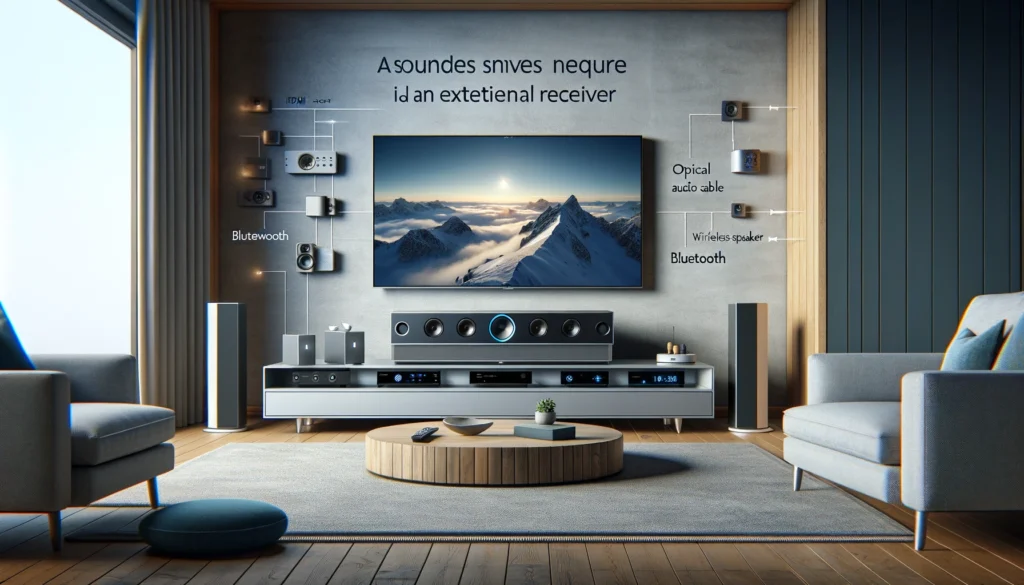
In most cases, you do not need an external receiver to use a soundbar. One of the main advantages of a soundbar is that all of the amplification and audio processing is self-contained within the soundbar unit itself.
Basic soundbars are designed to get an audio signal directly from the TV via HDMI ARC, optical audio cable, or a Bluetooth connection from your mobile device media player. With the electronics built into the bar, that is all that is required for it to output sound.
More advanced wireless surround soundbars may link up with additional satellite speakers or a wireless subwoofer.
However, the soundbar acts as the hub and amplifier for the satellite speakers, using the built-in wireless transmitter and receiver to connect everything. So you still do not need an AV receiver for these types of setups.
If you want true wireless surround with rear speakers for home theater, you would opt for a full 5.1 or 7.1 wireless speaker package, which would then require an AV receiver with wireless transmission capabilities to power everything.
In summary, for standalone soundbars or even soundbars with satellite speaker additions, an external receiver is not necessary. The processing, amplification, and connectivity are handled in the self-contained soundbar system.
Only once you get into more immersive home theater setups with multiple speakers surrounding the room would you require amplification from an AV receiver to power and process sound for the additional speakers.
Soundbar Connectivity Options

There are a few different wired and wireless connection options that allow a soundbar to receive audio signals from the TV without needing an external receiver. Common soundbar connectivity options include:
HDMI ARC/eARC – The HDMI ARC (Audio Return Channel) input is the most common way to connect a soundbar. This allows the TV to send audio directly to the soundbar via the HDMI cable.
The eARC standard builds on ARC for higher bandwidth and surround sound data transfer. Using HDMI ARC or eARC avoids needing to also run an optical audio cable between TV and soundbar for digital audio signal.
Optical Audio Cable – If a soundbar or TV lacks HDMI ARC support, an optical audio cable can be used instead. This allows for digital stereo PCM or Dolby Digital audio to be passed from TV to soundbar.
Optical cannot transmit high resolution audio like Dolby TrueHD or DTS HD Master formats however.
Bluetooth – Most soundbars have Bluetooth connectivity to wirelessly stream audio from mobile devices and computers directly to the speaker.
Via Bluetooth, the soundbar turns into the output speaker but still utilizes its built-in amplifier without need for an external receiver.
WiFi and Wireless Casting Protocols – Many higher-end soundbars also support streaming over WiFi via Chromecast, Airplay 2, or proprietary wireless platforms.
Similar to Bluetooth, this allows wireless audio transmission to the soundbar from smartphones, tablets, computers etc.
The main interconnectivity benefit of soundbars is not needing extra wired receiver connections in the room for speaker cables or surround sound setup.
The processing and amplification is built into the bar, with basic wired digital audio or wireless casting to receive the audio signal from TVs or mobile devices.
Soundbar vs Home Theater Setup
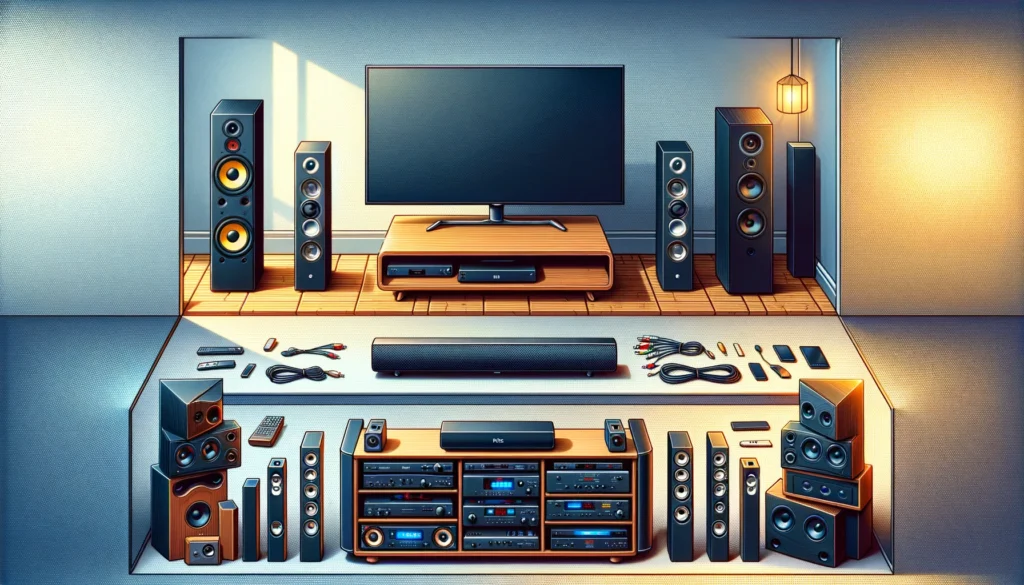
There are some key differences between choosing a plug-and-play soundbar compared to installing a full home theater setup:
Convenience – A soundbar is designed for easy self-installation, often with just a single HDMI cable connecting to TV and built-in wireless. Complete receiver home theater setups require running multiple speaker wires, placement of surround speakers, amp installation.
Price – Basic soundbars start around $100. Adding rear speakers, subwoofer, AV receiver and wiring for immersive surround can cost $1000+
Expandability – Most soundbars are self-contained systems, but higher-end models can expand to add wireless subwoofer and satellite speakers.
A full home theater setup built around an AV receiver offers more flexibility for adding speakers like Dolby Atmos height channels.
Audio Quality – Well-built soundbars can provide very good audio quality improvement over plain TV speakers. But home theater setups with large front speakers, dedicated powered subwoofers and surrounds provide a notch higher sound performance overall.
In summary, soundbars offer an easy audio upgrade in a simple package, while surround receiver systems provide better expandability and audio quality but require much more custom installation complexity in the room.
Do You Need an AV Receiver for Surround Sound?
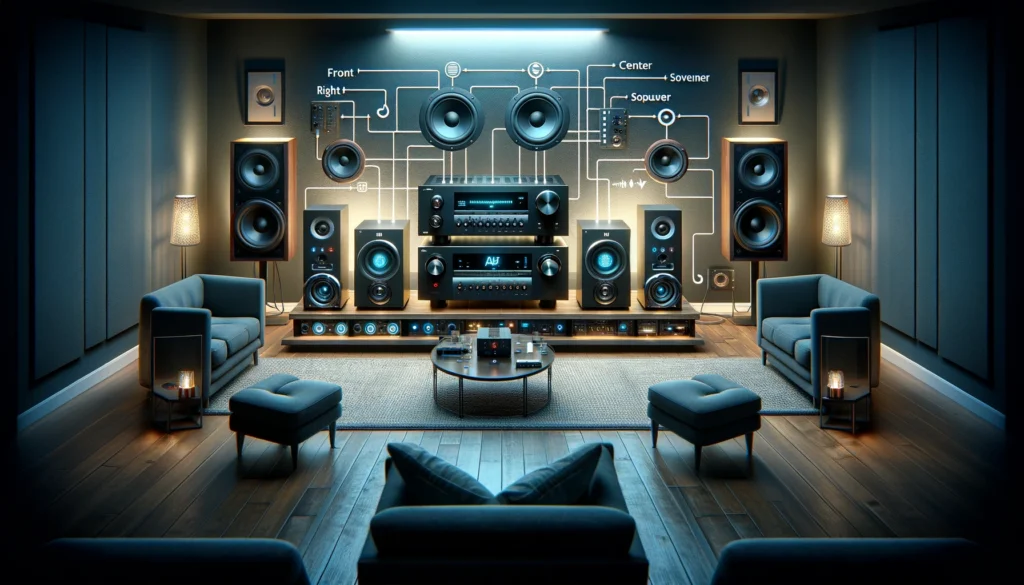
If you wish to create a true surround sound system with audio speakers placed around the room, then yes, you do need an audio-video receiver.
While some high-end soundbars simulate surround effects, you cannot properly power additional left, right, and rear surround speakers without an AV receiver to process and amplify the discrete channels.
Here are some reasons why an AV receiver is required for surround speaker setups:
Power Multiple Speakers – The amplification from soundbars is designed for the built-in speaker elements, not adding several larger external surround speakers in a room. AV receivers provide ample wattage to power 5+, 7+ or more speakers properly.
Process Discrete Channels – Soundbars mainly mix audio channels down to 2.1 or 3.1 output. AV receivers have processing like Dolby Digital and DTS to decode 5.1, 7.1 discrete surround channels and output them to the correct speakers.
Speaker-Level Connections – AV receivers have speaker wire terminal connections for hooking up left, right, center, surround and height speakers, which soundbars lack.
Advanced Audio Decoding – AV receivers properly decode advanced surround sound formats like Dolby Atmos TrueHD and DTS:X that provide immersive object-based sound that soundbars cannot fully replicate.
Custom Configurations – AV receivers allow custom tuning of settings like speaker distances, bass management crossover, EQ levels that allow for fine-tuning surround setups in a room.
In short, powered surround sound speaker setups with left, center, right, rear, and even height speakers necessitate an AV receiver to provide the proper power, discrete processing, and custom tuning capabilities.
Soundbars alone cannot properly drive these true customized home theater configurations.
Considerations for Choosing Soundbar vs Receiver Setup

When deciding whether to get a simple soundbar or take on the more complex install of a true surround receiver setup, here are some factors to weigh:
Room Size – Small rooms may not be well suited for a full set of surround speakers, making a compact soundbar a logical choice. Larger rooms can better incorporate immersive speaker setups.
Future Expandability Needs – With an AV receiver setup, you can always start with a 3.1 system and add speakers later as the budget allows. Soundbars offer less flexibility.
Audio Quality Expectations – Soundbars excel over TV speakers but even premium models cannot match the performance potential of high-end receivers with large speakers and powered subwoofers.
Source Material Compatibility – Soundbars may struggle to fully process the newest surround formats. AV receivers have the advanced decoding capabilities to fully leverage next-gen Dolby Atmos and DTS:X mixes.
Installation Complexity Tolerance – Soundbars simply plug into the TV out of the box while surround setups demand wiring knowledge and placement planning abilities.
Budget Limitations – With some exceptions, soundbars generally cost significantly less than building a comparable surround system including the receiver, multiple speakers and subwoofer.
Ease of use and convenience are the main advantages of soundbars, while AV receiver surround setups offer superior expandability and audio performance for a premium immersive experience.
Choose based on room size, audio expectations, complexity tolerance, and budget allowance. Those needing truly advanced Atmos and DTS:X decoding for movies are best served by a true surround receiver and speaker package.
For simpler spaces and audio improvement needs, soundbars pack impressive performance in a singular box.
Conclusion
In conclusion, soundbars provide a simple audio upgrade over standard TV speakers, without the complexity of installing a full home theater system. For their convenience and tidy footprint, soundbars pack an impressive audio punch.
But for more advanced surround sound or future expandability, a receiver-based system may be required.
Evaluate your room size, audio expectations, installation capabilities and budget to decide between the plug-and-play experience of a soundbar or the custom tuning and immersive sound performance of an AV receiver and speakers.
